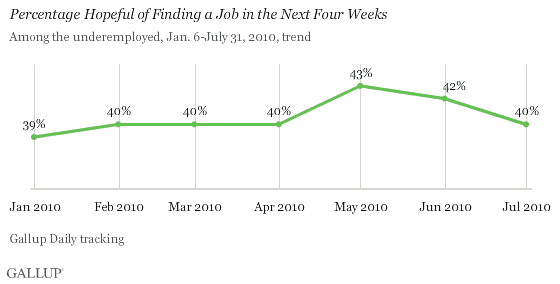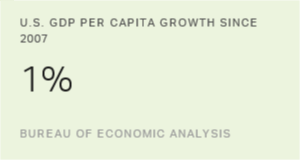PRINCETON, NJ -- Underemployment, as measured by Gallup, was 18.4% in July, essentially unchanged from 18.3% at the end of June and in mid-July. Underemployment peaked at 20.4% in April.

Gallup's underemployment measure includes both Americans who are unemployed and those working part time but wanting full-time work. It is based on more than 17,000 phone interviews with U.S. adults aged 18 and older in the workforce, collected over a 30-day period and reported daily and weekly. Gallup's results are not seasonally adjusted, and tend to be a precursor of government reports by approximately two weeks.
Changes in Unemployed and Part-Time Employees Wanting Full-Time Work Offset
The unemployment rate component of Gallup's underemployment measure fell to 8.9% at the end of July -- down from 9.2% at the end of June and 9.3% in mid-July. However, this decrease was more than offset by an increase to 9.5% in the percentage of employees working part time but wanting full-time work.

Substantially Higher Underemployment Persists Among the Young
Americans aged 18 to 29 had easily the highest underemployment rate in July of any age group, at 28.4%, including 11.8% who were unemployed and 16.6% who were employed part time but wanted full-time work. Among all U.S. adults in the workforce, a higher percentage of women than of men are underemployed.

Less Educated Face High Underemployment
Workers without any college education are more likely than those with more formal education to be underemployed.

Underemployed Are Less Hopeful
The percentage of underemployed Americans who are "hopeful" that they will be able to find a job in the next four weeks fell to 40% in July -- down from the better levels of May (43%) and June (42%).

No Real Improvement in Job Market Conditions
Gallup's modeling suggests that July's U.S. unemployment rate will remain at 9.5% or possibly decline to 9.4% -- below the 9.6% consensus -- when the government reports its figures on Friday. This is consistent with the ADP report of 42,000 private sector jobs being added and the Challenger report that layoffs remain down. Of course, the hiring and firing of census takers and seasonal adjustments make the jobs picture particularly murky right now.
While any decline in unemployment may be cheered on Wall Street, the real focus should be on the lack of improvement in underemployment. The magnitude of the 28.4% underemployment rate among those aged 18 to 29 and 23.0% among those without any college education creates significant social and economic challenges for the U.S.
On Monday, Federal Reserve Chairman Ben Bernanke noted that, "significant time will be required to restore the nearly 8½ million jobs that were lost over 2008 and 2009." That same day, Treasury Secretary Tim Geithner stated that the unemployment rate is likely to increase at some point during the coming months. If this is the case, then the country's leaders need to figure out how the nation deals not only with the long-term unemployed, but also with the long-term underemployment facing younger and less-educated Americans.
Gallup Daily tracking will provide continuous monitoring of the jobs situation in the weeks and months ahead.
Gallup.com reports results from these indexes in daily, weekly, and monthly averages and in Gallup.com stories. Complete trend data are always available to view and export in the following charts:
Daily: Employment, Economic Confidence and Job Creation, Consumer Spending
Weekly: Employment, Economic Confidence, Job Creation, Consumer Spending
Read more about Gallup's economic measures.
Survey Methods
Results are based on telephone interviews conducted as part of Gallup Daily tracking July 1-31, 2010, with a random sample of 17,922 adults, aged 18 and older, living in all 50 U.S. states and the District of Columbia, selected using random-digit-dial sampling.
For results based on the total sample of national adults, one can say with 95% confidence that the maximum margin of sampling error is ±1 percentage point.
Interviews are conducted with respondents on landline telephones and cellular phones, with interviews conducted in Spanish for respondents who are primarily Spanish-speaking. Each daily sample includes a minimum quota of 150 cell phone respondents and 850 landline respondents, with additional minimum quotas among landline respondents for gender within region. Landline respondents are chosen at random within each household on the basis of which member had the most recent birthday.
Samples are weighted by gender, age, race, Hispanic ethnicity, education, region, adults in the household, cell phone-only status, cell phone-mostly status, and phone lines. Demographic weighting targets are based on the March 2009 Current Population Survey figures for the aged 18 and older non-institutionalized population living in U.S. telephone households. All reported margins of sampling error include the computed design effects for weighting and sample design.
In addition to sampling error, question wording and practical difficulties in conducting surveys can introduce error or bias into the findings of public opinion polls.
For more details on Gallup's polling methodology, visit https://www.gallup.com/.
